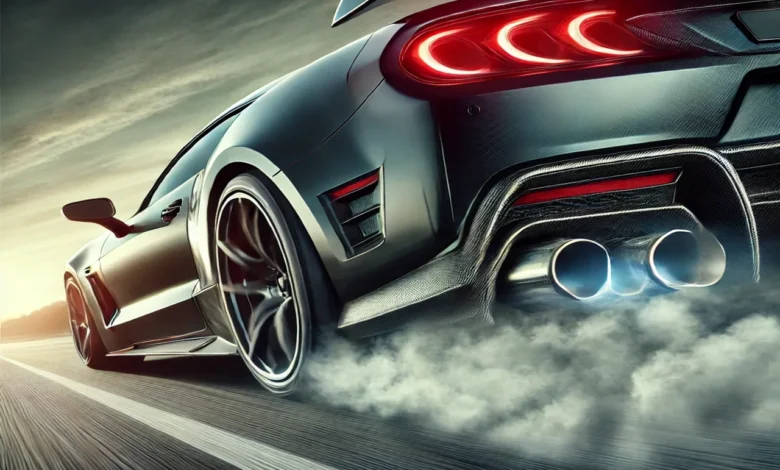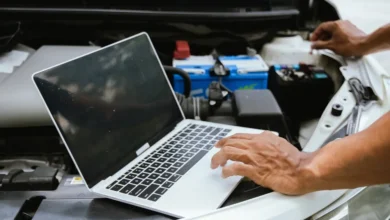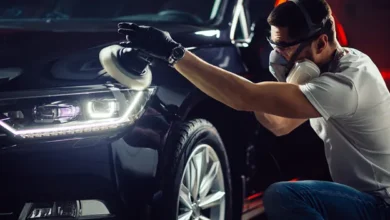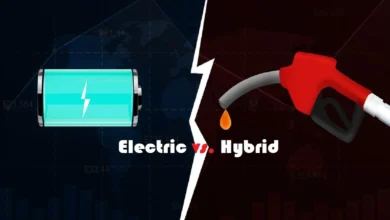
Indeed, something about hearing the deep growl of your car sends shivers down your spine. As a car enthusiast, you probably know that the exhaust system does not simply exhaust gases but brings your engine alive. The right exhaust system will change your driving experience from a giving satisfying sound to even higher performance. But which exhaust system should you go for? Whether you need to up the ante in your sports car or fine-tune your exhaust for some extraordinary performance, we have it.
Top 5 Aftermarket Exhaust Systems (With Pros, Cons, and Compatibility for Sports Cars)
An aftermarket exhaust system is one of the best modifications you can do to a car; however, with all the choices on the market, knowing what each system provides is essential. Here are the most sought-after aftermarket exhaust systems, their pros and cons, and how well they fit sports cars.
1. Cat-Back Exhaust Systems
Cat-back is an exhaust system that substitutes the piping and muffler from the catalytic converter back to the tailpipe. The catalytic converter in this system remains intact, meaning you remain within limits of exhaust-emission compliance and still enjoy better airflow. It enhances both the sound and performance, which is one reason why it enjoys wide popularity among enthusiasts to achieve a productive upgrade without the hassle of changing the whole exhaust system.
Pros:
- Better Performance: While not as significant as header-back systems, these cat-back exhausts do offer some moderate performance improvements by reducing the back pressure caused by the exhaust.
- Loud Aggressive Noise: These cat-back exhausts have a better sound profile compared to their original equipment in its standard form. Expect a much louder and deeper exhaust note.
- Street Legal: Since the catalytic converter is left untouched, the majority of these cat-back systems are almost always EPA-compliant and thus allowed to be driven on most streets.
- Better Fuel Economy: At times, it provides better mileage due to improved exhaust flow when traveling at faster velocities.
Cons:
- Moderate Gains: You would not get the type of performance gain as you would get when you completely rebuild the exhaust.
- Expensive: High-quality cat-back systems are not cheap. They can be pretty pricey, especially if they are stainless steel.
Sports Car Compatibility:
✔️ Yes. For any sports car, the cat-back systems are an excellent choice since they give a fair balance between sound and performance that will definitely change the character of your car without having emissions modifications. Whether a Mustang, a Subaru WRX, or a BMW M3 is being driven, a cat-back exhaust makes your car come alive.
2. Axle-Back Exhaust Systems
An axle-back exhaust system is the replacement of the exhaust components from the rear axle to the tailpipe. This often simply consists of the muffler and sometimes the tailpipe. Unlike cat-back systems, axle-back setups do not interfere much with the performance; instead, they tend to focus on the sound and visual aspects.
Pros:
- Amazing Sound Enhancement: Axle-back systems greatly change your tone of exhaust. You will experience a much louder and more aggressive exhaust note.
- More Affordable: The cost is more manageable because Axle-back exhaust systems are cheaper than full cat-back or header-back systems, which is perfect for those who are really looking for sound.
- Easy Installation: It has fewer components, making the process of installation easier and quicker, which can be done at times in a couple of hours.
Cons:
- Minor Performance Improvement: Axle-back exhaust systems do not improve exhaust flow as much as bigger systems, in turn, resulting in fewer or minor improvements in performance.
- Limited Scope: This system doesn’t touch the catalytic converter or mid-pipe. Therefore, it will have minimal emissions and airflow impact compared to a cat-back system.
Sports Car Compatibility:
✔️ Yes. Axle-back systems are just perfect for enthusiasts of sports car in case one needs sound rather than the raw performance. They give the sports car that aggressive exhaust note but will not break the bank. However, if you are looking to have noticeable horsepower gains, then the more comprehensive system would have to make a cut.
3. Crossmember-Back Exhaust Systems
A crossmember-back exhaust system replaces the exhaust system from behind the crossmember-a structural bar that supports the vehicle’s chassis to the tailpipe. It is less common for sports cars and well-suited to trucks or muscle cars.
Pros:
- Middle Sound Upgrade: You will still benefit with a good sound upgrade by having a crossmember-back system. However, it’s not as dramatic as other systems.
- Plain Design: It is less complex and more affordable as compared to the header-back or turbo-back systems.
Cons:
- Less Performance Upgradation: Crossmember-back systems are just like axle-back systems, providing very little performance upgradation.
- Not Common in Sports Cars: Crossmember-back systems are not common and few systems are available even for a sports car.
Sports Car Compatibility:
❌ No. Crossmember-back applications are mostly for trucks and muscle cars primarily, mainly because of the need for that special chassis format. Not so much with sports cars though, as performance gains are minimal and the design is not quite aggressive enough to take on and deliver full high-performance handling demand.
4. Header-Back Exhaust Systems
The most extreme form of exhaust modification is a header-back exhaust system, which replaces all the exhaust components from the engine headers to the tailpipe. This does this by totally eliminating exhaust backpressure to a great extent and thus realizes significant performance gains.
Pros:
- Maximum Performance: This system has the greatest horsepower and torque gains in improving exhaust flow throughout the entire system.
- Customizable Sound: You are able to totally have full control over the exhaust note and flow characteristics since you are replacing everything.
- Increased Engine Efficiency: Reduced back pressure equates to increased efficiency in the working of an engine, especially at higher RPMs.
Cons:
- Costly: Header-back is the most expensive among all the types of exhaust modification.
- Complex Installation: It demands more labor and experience to install. Moreover, professional help might be needed.
- Emission Issues: In some cases, a header-back system may require modifications to the catalytic converter, which could affect emissions compliance.
Sports Car Compatibility:
✔️ Yes. Header-back systems are ideal for high-performance sports cars. If you’re aiming for maximum horsepower gains and have a track-focused car, a header-back exhaust system will deliver the best results. It’s a must-have for enthusiasts who want to push their engine’s performance to the limit.
5. Turbo-Back Exhaust Systems
A turbo-back exhaust system is designed specifically for turbocharged applications. It is a direct replacement of all the components from the turbocharger’s outlet down to the tailpipe. It reduces backpressure on the turbo, which drastically increases turbo efficiency and takes a big chunk out of that premature lag in the engine.
Pros:
- Immersion Turbo Efficiency: Turbo-back systems especially optimize the exhaust flow, which enhances the responsiveness of the engine and reduces turbo lag.
- Huge Power Gain: Turbocharged engines get a great deal of power from this system-there are often enormous horsepower gains.
- Customizable Sound: The perfect turbo whistle or aggressive roar can be dialed in, depending on the design and materials used.
Cons:
- Turbo-Only: This system is only beneficial for turbocharged cars.
- Complex Installation: As with the header-back systems, professional installation is required, and fitment is a little more complex than header-back systems as well.
Sports Car Compatibility:
✔️ Yes, but only for turbocharging sports cars. If you’re driving something like a Subaru WRX STI, a Ford Mustang EcoBoost, or a turbocharged Nissan 370Z, it’s a turbo-back system that will really open up a performance chasm.
The Sound You’ve Been Looking For: What System Does You Need?
Whether you are a junkie for the sound or an enthusiast for performance, in one case, one thing is guaranteed; it is that the sound your car will be making tells a lot about the personality of your car. That is how you and your car want it to sound like. The choice for right system for your exhaust depends on how one wants his car to perform and its entire sound-making characteristics. Here’s how to decide which system to have.
Sound Lovers vs. Performance Enthusiasts
If the rumble of your car’s engine gets you revved up, then noise should be number one on your checklist. Axle-back or cat-back exhausts will give you that growl you want, maybe even a bit too much to handle, but that is not going to put a dent in the wallet nor require so many modifications. For the true high-performance enthusiasts, the axle-back exhaust is going to be fantastic for that loud growl when they hit the throttle, and do not worry how it impacts performance-that isn’t going to see very large increments, but that deep rumbly sound is going to turn some heads.
On the other hand, if you are a performance freak, then you’re going to want to invest in something more comprehensive like a header-back exhaust. This system not only enhances the sound of your car but also maximizes horsepower and torque levels. The whole game is backpressure reduction, flow enhancement, and allowing your engine to breathe. The downside to all this is that you’re going to pay for it, but you’ll certainly be rewarded at the track or street.
How Exhaust Systems Affect the Health of Your Engine
One of the things that you are going to want to pay attention to in buying an exhaust system is how it will affect the health of your engine. The wrong system or poorly installed exhaust components can increase backpressure and siphon-off efficiency. When exhaust gases are not expelled efficiently, there is the possibility that the engine has to work harder, causing engine wear and tear over time.
For example, a badly installed turbo-back exhaust on a turbocharged engine can do more bad than good by generating excessive or inadequate backpressure, impacting the spool time of your turbos. Make sure your exhaust system is designed to match the type of engine you are using and your performance goals.
Installing Your Aftermarket Exhaust System
Now that you have chosen which system works best with your ride and driving, it is time to install the system. But here’s the catch—should you do it yourself, or leave it to the pros? Let’s break it down.
DIY or Professional Install
Then there are also exhaust systems that a DIY enthusiast can try to install with relatively little effort. Axle-back and cat-back setups usually are considered easier to install due to fewer components and non-interference with the catalytic converter. Provided you have a rather good set of tools, a jack, and a little bit of patience, the installation of your new exhaust system can be done over the weekend.
Be careful, though —header-back and turbo-back systems are much more complicated. These put the entire exhaust from the engine or turbo all the way to the tailpipe. Many require custom fittings, modification to catalytic converter, or sometimes even engine tuning. Unless you have experience working on internal engine mechanicals, the more complicated installations should be left to the pros.
Common Installation Mistakes
It’s not that simple to install after-market exhaust. Bury the following common mistakes.
- Torquing down the bolts: This is one of the errors that may result in an exhaust leak if the bolts are not torqued down correctly. Try to get hold of torque specs provided by the manufacturer.
- Misaligning the Exhaust: Alignment determines whether the exhaust may rattle or hit other car parts and may cause noise or damage to some parts.
- Forgetting the Test Fit: In test-fitting, exhaust systems should be fitted in beforehand before fully tightening all of the bolts. This insures that everything is properly aligned with each other and can fit inside the car’s chassis.
- Failure to Use High-Temperature Sealant: A high-temp sealant applied around the joints of your exhaust system will prevent leaks in your system.
Tools and Equipment Needed
To avoid hiccups during installation, make sure you have the following tools at hand:
- Socket Wrench Set: Used in loosening and tightening of bolts
- Torque Wrench: Ensure that all bolts are torqued to specification
- Exhaust Hanger Removal Tool: To remove old exhaust hanger without getting damaged
- Jack and Jack Stands: To give you ample clearance to work underneath your car
- High-Temperature Sealant: Used to seal up joints to prevent leaks
- Safety Glasses: When working under your car, it is best to always protect your eyes.
Header-back and turbo-back systems generally require special tools and potentially the removal of other components, like an intake manifold, to properly accommodate the exhaust system.
You might also like: Vehicle Maintenance and Repair Approach
How Performance Gains and Sound Evolve Over Time
One of the most exciting things about an aftermarket exhaust system is the immediate change in performance and sound. But the various benefits are likely to evolve over time, mostly as your system “breaks in”.
What to Expect Post-Installation
The moment you install your exhaust system, it’s going to be distinctly heard and felt regarding the performance. Axle-back and cat-back systems give a deep, growling, aggressive sound as you fire the engine. The same performance is associated with moderate but noticeable gains from a cat-back system: slight improvements regarding throttle response and acceleration are noted in the process.
An even larger performance gain can be expected with the installation of a header-back or turbo-back exhaust. In these types, backpressure is very minimal, and your engine works much more efficiently. A smooth power curve and top-end power will be experienced, making it essential for track performance.
Breaking in Your Exhaust System
Just like a pair of new shoes, your exhaust system takes a little bit of time to break in; the sound will level out in the initial few weeks into its final tone. Initially, an exhaust might be louder or sharper, but as the material expands and contracts from those heat cycles, it starts developing that deeper note, more refined.
It’s not the only thing that will change. With it is loosened up, and with the engine learning this new setup, performance can even be enhanced. Turbocharged engines in particular are to gain, since this decreased backpressure causes the turbo to spool more quickly over time.
Keeping Your System in Tip Top Condition
To keep your exhaust system in the best possible shape, you should consider these following tips for maintenance:
- Inspect Regularly for Leaks: Look for exhaust leaks around the joints, as these will always decrease performance and raise fuel consumption.
- Clean the Exhaust System: The systems tend to collect dirt and grime gradually. A good clean not only keeps it looking sharp but also prevents corrosion in areas exposed to moisture.
- Check for Rust: Stainless steel kits are more resistant to rust; however, they do develop it. If you live in an area where the roads often come wet or salty, then check your pipes periodically for any signs of rust.
- Check out at the Hangers: See if your exhaust hanger is tight and still feels tight. If this hanger is loose, then this can have a tendency of rattling noises and future damage on other parts of your car.
- Listen for Changes in Sound: Different tone in your exhaust may indicate a leakage or crack in the system. Whenever you feel that your car has begun to produce an odd sound, check it right away.
Choosing an Exhaust System That Is Right for You
The large number of options most likely poses a question on your mind: how would you know which aftermarket exhaust system is best suited for you? Here are the most important factors to consider.
1. How Much Does It Cost?
Exhaust systems range in price from cheap axle-back setups to high-end header-back systems that have a price that’s easily reached into the thousands of dollars. On a tight budget, you will find the best bang for your buck within a cat-back exhaust. These systems provide a good balance of performance and sound without taking on the expensive full systems costs.
On the other hand, if you fear not to spend a little extra cash in return for maximum performance, then a header-back exhaust or a turbo-back system is the way forward. Remember, though, that you are paying for the exhaust itself as well as other installation costs, which can be quite expensive in a more complex system.
2. Brand Reputation
All brands are not the same when it comes to aftermarket exhaust systems. The following are the most trusted brands:
- Borla: Aggressive sound and stainless steel durability.
- MagnaFlow: Ideally well-balanced performance and sound.
- Flowmaster: Muscle cars, trucks; car systems deliver that deep, throaty growl.
- Akrapovič: High-end, lightweight exhaust systems used by high-end sports cars, such as Porsche and Ferrari.
- Invidia: Great for more or less high-performance sports cars, especially on Subaru WRX and Mitsubishi Evo.
Read reviews and look at forums to see what other folks are saying about that exhaust you are considering.
3. Materials and Longevity
The material in an exhaust system largely determines how long it will last and how well it’ll perform. There are two types of materials available:
- Stainless Steel: Resistant to corrosion and long-lasting, but could be a bit pricey. In case an individual stays in a wet climate or close to the ocean, stainless steel is the best upgrade that will definitely resist rust.
- Aluminized Steel: The most economical, but less durable. Compared to systems made of stainless steel, aluminized steel systems are less expensive; thus they will rust faster, especially in tougher climatic conditions. It’s a good option if you wish to upgrade on a budget and you have no problem replacing the system sooner.
Legal Aspects: Noise and Emission Regulations
Most people forget something when installing that much-needed aftermarket exhaust system. There are critical regulations locally about exhaust noise levels as well as emissions. Not complying with these might land you with humongous fines, or worse, condemn your car as illegal for street use.
Knowing What the Local Laws Are
Every area has its own regulation for exhaust systems. In the United States, for example, there is strong law when it comes to emissions, but primarily, the state law takes care of sound level conditions. California is an extreme example, following more drastically standardized standards compared to CARB, California Air Resources Board, in both emissions and alteration of aftermarkets, where its features will not develop any air quality deterioration.
In the UK, it is the MOT (Ministry of Transport) test that tests the noise of your exhaust. If too loud, it might make it fail the MOT. EU regulations also demand aftermarket exhausts be within certain limits on noise and emissions.
This means for car enthusiasts, learn your local laws before modifying your exhaust system. If you install a non-compliant exhaust for your car, local authorities may have a word with you, especially if your car does not pass the emission test or is too loud for a street-legal car.
Street Legal vs. Off-Road Only
It can thus distinguish between an exhaust system which is street-legal and that meant to be off-road only. For example:
- Street-Legal Systems: These systems conform to local emissions and noise standards. For the most part, following cat-back or axle-back exhausts will put you within the bounds of emissions standards, as those systems do not touch the catalytic converter.
- Off-Road Exhausts: Most headers-back as well as turbo-back exhausts delete or replace the catalytic converter, hence they’re not street compliant. These usually come with the signature “off-road only” and are best for track cars as well as for cars that do not need visual examination against street standards.
If you are not sure whether the exhaust system you are eyeing is CARB-compliant or not, check on its acceptance against your local MOT or EPA standards.
Noise Laws
Most aftermarket exhaust systems boast a much more aggressive pitch than the standard units, which is fine and dandy for enthusiasts but not quite so for neighbors or the police. Noise laws vary significantly, but as a general guideline, if your exhaust system is too loud, you may be fined or even have your car impounded.
For example, California limits the exhaust noise of a car to 95 decibels on ordinary passenger cars, and other European countries limit them even lower. On some exhausts, mufflers or silencers can be adjustable. Lower the noise level when riding on the street, and then crank it up when you really are on the track.
Find the Right Exhaust and Feel the Power
In fact, modern exhaust is more than a change in cosmetic or audio but an actual means to unlock maximum performance from your car. Want that deep, throaty roar? Done. Performance junkie looking to squeeze out every last drop of horsepower? Exhaust system, here’s one for you.
The after-market exhaust systems are beautiful because you can make them conform to your own driving style and pleasure. There is no one-size-fits-all but with the right exhaust system, you feel its power every time you put your foot down on it.
So go ahead, find the proper exhaust to make your car roar, feel that thrill, and enjoy your ride. Your car is so much more than a mere machine; it talks for the type of driver you are. Let it be counted for.
We hope you found this article helpful. If you did, be sure to check out our blog for more great content like this.





